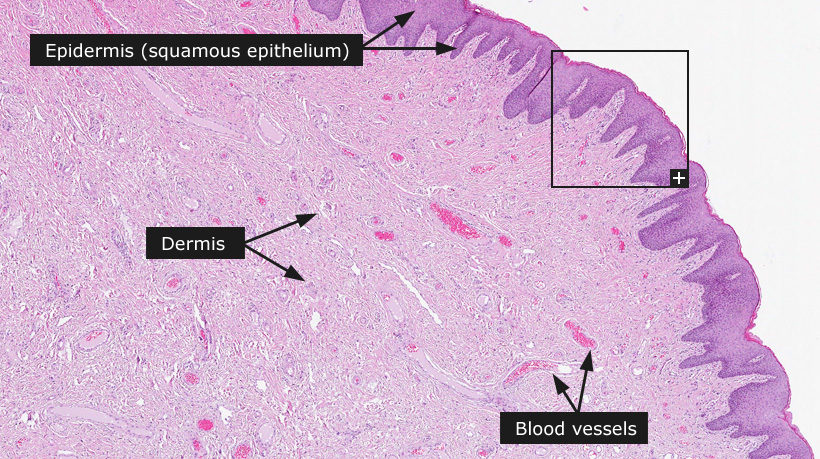Anal skin

Anal skin
The skin can be divided into three main parts, the epidermis forming the outermost layer of the skin, the underlying dermis and the deeper located subcutis. The human epidermis is on average 50 µm thick with a surface density of 50.000 cells per mm². The epidermis is a stratified epithelial sheet composed mainly of keratinocytes. Keratinocytes are strongly attached to each other through desmosomes. The epidermis also includes resident cells and these consist of the pigment producing melanocytes, the antigen presenting Langerhans cells and the neuroendocrine Merkel cells. The epidermis is separated from the dermis by the basement membrane, a complex multilayered specialized structure of attachment molecules.
Residing on the basement membrane is the basal layer of keratinocytes that contains the proliferating basal cells. Keratinocytes that leave this layer undergo terminal differentiation. The prickle cell layer is located above the basal cell layer and in this layer keratinocytes acquire more cytoplasm and well-formed bundles of keratin intermediate filaments. As the keratinocytes are pushed further outwards, proteins that constitute the cell envelop and keratohyaline granules of the stratum granulosum are synthesized. The end stage of epidermal keratinocyte differentiation results in a dense keratinous layer, the cornified layer consisting of flake-like squames that are eventually shed. The total epidermal renewal time is two months. Approximately 25-40 days are required for the designated epidermal stem cells that underlie the constantly self-renewing epidermis to develop into cells of the granular layer and passing through the cornified layer takes an additional 14 days.
The melanocyte is a neural crest -derived cell that migrates into the epidermis and hair follicles during embryogenesis. Melanocytes are characterized by their unique organelle, the melanosome that is essential for the melanin biosynthetic pathway. Melanocytes are dendritic cells that can produce, transport and deliver melanin pigment to the keratinocytes. Melanocytes reside in the basal layer. Each melanocyte has contact with some 30-40 keratinocytes through its dendrites. Melanocytes can be stimulated by ultraviolet radiation to increase melanin production and transport. Langerhans cells are of monocytic lineage and derived from the bone marrow. Langerhans cells appear as dendritic cells residing in the prickle cell layer of epidermis and play a crucial role in the presentation of antigens that enter the skin or are produced within the skin. In the presence of inflammation, Langerhans cells become activated to leave the epidermis and migrate to draining lymph nodes. Merkel cells reside in the basal layer and are highly innervated neuroendocrine cells that are involved in mechanoreception. Merkel cells are often associated with epidermal appendages and nerve fibers. Merkel cells are most dense in volar skin.
Located beneath the epidermis is the dermis consisting of a vascularized connective tissue that provides nutritional and structural support. The dermis is composed of a mucopolysaccharide gel that is held together by a collagen and elastin matrix. Vascular structures, nerves and mast cells are found throughout the dermis together with the other dermal resident cells consisting of fibroblasts, dermal dendritic cells and macrophages. The dermis can be roughly divided into an upper papillary dermis consisting of finer fibrillar collagen and a deeper located reticular dermis with dense collagen fibers. Below the dermis is the subcutis consisting of mature adipose tissue arranged in lobules separated by thin fibrous septa.
The skin also includes the skin appendages (hair, nails, eccrine and apocrine sweat glands and sweat ducts). Hair follicles include sebaceous glands and are connected to arrector pili muscle fibers. The development of skin appendages is based on epithelial-mesenchymal interactions to produce miniature organs, containing cells that follow specialized routes of differentiation, to add important functions to the skin.
|